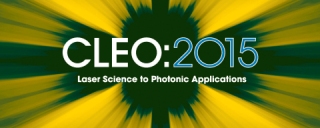Mar 10 2015
Sharing their insights on microscopy and trends in optics, six Nobel Prize winners and two laser luminaries will deliver plenary keynotes at CLEO 2015, the premier international forum for scientific and technical optics, 10 – 15 May 2015, at the San Jose Convention Center, California, USA. Nobel Prize winners in Chemistry, Stefan Hell and Eric Betzig, will join Nobel Prize winners in Physics, Steven Chu and W. E. Moerner, in the opening plenary session dedicated to the topic of Microscopy.
2014 Nobel Prize Winner in Physics, Hiroshi Amano, and Tony Heinz, Tony Heinz, David M. Rickey Professor of Optical Communications at Columbia University, will lead the discussion on the widespread capabilities of light sciences. Nobel Prize Winner in Physics, Shuji Nakamura, and Miles Padgett, Kelvin Chair of Natural Philosophy at the University of Glasgow, Scotland, will spearhead a celebration of the International Year of Light.

“Individually each of the speakers scheduled for CLEO 2015 plenary offer groundbreaking contributions to the field, but together these luminaries lead a path of limitless opportunities,” said Yurii Vlasov, general co-chair of CLEO. “All eight renowned speakers advance the conference program to a new level. The plenary always serves as a key forum for the exhibit, and with this year’s line-up, will undoubtedly exploit the foundation of the ongoing revolution in a wide range of applications.”
These sessions will be live on cleoconference.org.
Session 1: Monday 11 May 16:00 - 18:00 PDT
Microscopy
- Steven Chu, Stanford University, USA
Nobel Prize Winner in Physics 1997
Microscopy 2.0
One of the major problems in the detailed molecular understanding of the biology of genomes is that we cannot currently see what a protein does, where it is, and how it moves. As a result, most functional conclusions about a protein are necessarily indirect. In recent years, the invention of new imaging technologies is having a profound impact on biological sciences. Chu will discuss how a revolution in optical and electron microscopy will provide the tools that can have a profound impact on biology, biomedicine and bioengineering.
- Stefan W. Hell, Max Planck Institute for Biophysical Chemistry, Germany
Nobel Prize Winner in Chemistry 2014
Nanoscopy with Focused Light
Since the discovery that basic state transitions in a fluorophore can be exploited to eliminate the resolution-limiting role of diffraction, fluorescence microscopes are now able to resolve on the nanometer scale. Stefan Hell will deliberate the basic principles of these nanoscopy (superresolution) concepts with particular emphasis on the first viable far-field method, stimulated emission depletion (STED) microscopy. His talk will also show their scope of applications in the life sciences and other fields of research.
- W. E. Moerner, Stanford University, USA
Nobel Prize Winner in Chemistry 2014
Light Paves the Way to Single-Molecule Detection and Photocontrol; Foundations of Super-Resolution Microscopy
An expert in single-molecule biophysics and super-resolution imaging, Moerner will investigate the foundations for super-resolution microscopy beyond the diffraction limit with single molecules and tracking of single molecules in cells that continuously yield surprises.
- Eric Betzig, Howard Hughes Medical Institute, USA
Nobel Prize Winner in Chemistry 2014
Imaging Life at High Spatiotemporal Resolution
Three different technologies that balance the inevitable tradeoffs of spatial resolution speed and non-invasiveness in fluorescence microscopy will be described: 3D localization microscopy of cellular ultrastructure; nonlinear structured illumination microscopy of live cell dynamics in the sub-100 nm regime; and lattice light sheet microscopy of rapid 3D dynamic processes in life.
Session 2: Tuesday 12 May 13:30-14:30 PDT
Opportunities of Light
- Tony Heinz, Columbia University, USA
Electrons in Atomically Thin Two-Dimensional Crystals
Graphene, the two dimensional honeycomb lattice of carbon atoms, was first isolated a decade ago. Advances in our understanding of the properties of electrons confined to this material are exemplified by progress in atomically thin semiconductors, like the transition metal dichalcogenides, which exhibit many distinctive and attractive optical properties, alone and in combination with one another, at monolayer thickness.
- Hiroshi Amano, Nagoya University, Japan
Nobel Prize Winner in Physics 2014
Current and Future of Solid State Lighting
Amano, an International Year of Light special session speaker, will discuss the current problems with LED lighting. He will offer insights on new lighting technologies, which address these problems.
Session 3: Wednesday 13 May 13 18:30 – 20:30 PDT
IYL Celebration
- Shuji Nakamura, University of California Santa Barbara, USA
Nobel Prize Winner in Physics 2014
Energy savings by LED Lighting
In this presentation, Nakamura will offer insights to current and future energy savings by GaN and related compounds. He will explain how we can reduce the electricity needs to penetrate more than 70 percent of the LED lighting in Japan by 2020.
- Miles Padgett, University of Glasgow, Scotland, UK
Light’s Twist
That light travels in straight lines is a statement of the obvious. But within light beams energy and momentum can twist and twirl, carrying angular momentum that can spin particles, encode information and test quantum mechanics.